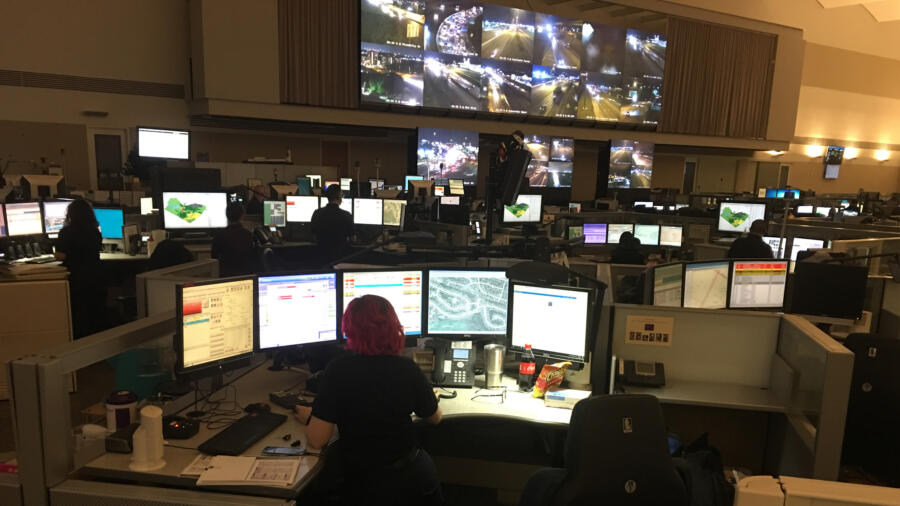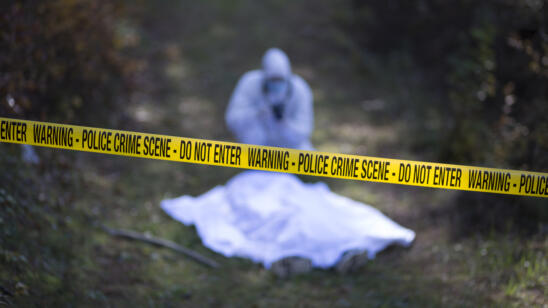It’s a given that 911 call centers around the country are at the ready for reports about car accidents or medical issues like heart attacks. But what happens when their operators get a call about a violent crime in progress?
JC Ferguson, commander of communications training for Austin-Travis County Emergency Medical Services—which is featured on “Nightwatch Nation”—manages several extensive training programs every year to ensure new employees are prepared for the stressful work ahead, including calls about violent crimes.
A&E True Crime spoke with Ferguson about the emotional toll such incidents can take on the often-unsung heroes in these cases: the call takers and dispatchers.
What happens when you get a call from the victim of a violent crime?
First and foremost, we need to know where they are so we can get them resources. Then our focus is safety—we need to make sure our caller—the victim—is safe, and that our responders are going to be safe once they get there. No matter what part of the triage we’re in, we will stop giving medical instructions to give safety instructions. An example of this is, ‘Leave the area immediately, and if you can, call us back from somewhere safe. Take the phone with you, if you need to hide and be quiet, to not let yourself be known or seen or heard, do that.’
Otherwise we’re going to ask, ‘Is the assailant still nearby?’ We need to know if that person is there, which puts the caller in danger, or puts us in danger. We’re also going to ask if weapons were involved or mentioned. [Maybe] they said a tire iron was involved, that the assailant is nowhere nearby, [or maybe the assailant] is still there and has a gun. Those are significant differences in deciding whether or not we [EMS] approach that scene or wait for law enforcement to let us know it’s safe.
How does it work when you hear from the victim via text? (Text to 911 is only available in certain areas, but Austin is one).
Let me create a scenario for you: [A victim texts,] ‘I’m a victim of domestic violence. I’m in fear for my safety. I need help; my partner is abusing me right now.’ [The response is,] ‘Police, fire, EMS?’ [And the texter writes,] ‘I don’t know. I’ve been punched, and he’s coming back for me again.’
We’ll get that text, because there is a victim at that point. There’s somebody who has been assaulted who needs an ambulance. [If the texter is still] in danger, we would say, ‘Stay silent, out of sight. Text me when you can.’ And we ask, ‘Do you feel like you can get out safely?’
When you’re on a call about a violent crime, what kind of decisions do you need to make as the call taker?
All I have is my voice, the way that I say words and the words I choose. My timeframe is short.
If I’m a field medic, yes, I have to act fast, to stop a bleed or to do whatever it is I’m doing. But I’m the one doing the acting. Over the phone, I have to convince someone else to do the acting, and I have seconds to get their address and location to send an ambulance. I have just a minute or two to provide an entire range of instructions before somebody shows up to take over. I’ve got under a minute to try to control an otherwise hysterical person and get them to do what I ask them to do.
What is that like for you?
The amount of energy it takes to tailor my words and my tone to try to get somebody to do that is exhausting [especially] when it doesn’t work and I can’t reach them, or they are aggressive or abusive in their response to our attempts to get them to do it. So when we’re doing that 40 or 50 times in a 12-hour shift, over time that ends up being incredibly stressful.
Are there times when you get a call while a violent crime is taking place?
[I’ve heard of instances where] a call taker is on the line…and the [caller] is screaming, ‘Hey this person is being stabbed, come hurry, quick, please get here,’ and we can hear the assault taking place.
It turns from screaming, to crying, to not crying as much, to silence. So we’re not just hearing the assault taking place, but hearing it transition from an assault in progress to what will turn into a murder investigation.
It’s hard to even imagine what that’s like for the person getting that call.
It is absolute helplessness. The only way I can try to project that to somebody else is, imagine standing behind a glass window, and watching somebody be assaulted—be it sexually assaulted, physically assaulted, emotionally assaulted or being murdered. And you have to watch it—with your ears, because we’re listening to it. You have to observe it. Your ability to change the course of that is limited to your caller’s ability to comply with your instructions.
In a situation like that, if we’re speaking to a bystander, by telling them to intervene, we’re [potentially] creating a second patient, or a third patient. We really just have to observe this process, which is one of the worst feelings in the world.
How do you handle a call from someone who is about to be attacked?
For a lot of these, we’re not even part of the call. Law enforcement deals with the initial contact with 911. For our local system, if you text or call 911, it will be the Austin Police Department or Travis County Sherriff’s Department that says, ‘Do you need, police, fire, or EMS?’ If the response is, ‘I don’t know. I think I’m about to be shot, or stabbed,’ that’s probably not going to make it to us in the first place. If we do receive something like that, our goal is to find out if someone there needs an ambulance. If they don’t need the ambulance or it hasn’t happened yet, then it’s not in our wheelhouse.
[But] we’re not going to abandon the caller. We’ll help them stay silent and get to a safe place if [they] need to. But in that moment, the absolute priority is making sure the appropriate law-enforcement agency is responding to keep that caller safe and making sure that the call taker has the location and the information they need to send officers.
Do the callers themselves ever threaten violence?
Less frequently. We’re focused 100 percent on EMS calls. If a person is threatening violence, unless it’s toward themselves or something that would indicate we need to treat them medically or psychologically, that’s more of a law-enforcement issue than an [EMS] issue.
What kind of emotional support is available to employees after potentially traumatic calls?
We have a clinical office practice, two staff psychologists, employee assistance and peer support. [But most importantly,] one of the things we foster here at the academy is team accountability and a teamwork atmosphere.
If somebody has to step away, we’ve got their back. We’re saying, ‘Go do what you need to do, we’re going to cover this.’
For that specific example I just gave you, there may be some tears immediately after disconnecting. That’s a collective effort between the person who took the call, their colleagues and the supervisor on that shift to say ‘Why don’t you go take a walk? I’m going to get your stuff together so you can go home and be with your family.’
By supporting each other and allowing each other the space to cry, to reflect, to cope with trauma and stress, we let [our coworkers] know that we’ve got their backs and that if they need a moment they can take a moment.
Do you feel your team is representative of call centers in other part of the country?
I think there’s an inherent cohesiveness that occurs with shifts like these [regardless of location]. It’s not like a police car or an ambulance where it’s just the two of you. Depending on your service across the country, there’s anywhere between two and 10 of you in very close quarters [in a call center].
I attended a conference last year where I got to listen to call takers and dispatchers in Las Vegas speak about their experiences during the [concert] shooting last year on Route 91. They said things like, ‘We’re from different walks of life and different backgrounds, but when something tragic, something so traumatic happens, there’s no one else I would rather be with than these people around me.
That’s the type of attitude and cohesiveness we have here at Austin-Travis County EMS. We do chuck wagon or potluck dinners where we get together, we break bread and we make sure that even though we may have tensions and disagreements with each other, we’re still a family.
Related Features:


